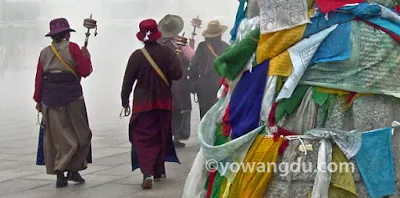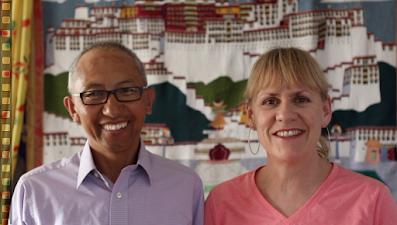Guest Post
Top 5 Things to Do in Lhasa, Tibet
by Yolanda O’Bannon and Lobsang Wangdu
images ©2019 Yolanda O’Bannon and Lobsang Wangdu
Lhasa, Tibet is like no other place on earth. Incredibly, despite more than 60 years of sinicization and systematic repression, Tibet is still powerfully, beautifully Tibetan, and you can still have an unforgettable experience in the Tibetan capital.
But you’re probably wondering: “How do I see the real Tibet, and not some Disney version of it?” We’re going to make that easy for you. If you want to maximize your time with Tibetan people, to rub shoulders with nomads and pilgrims and normal Tibetan folk, just follow our top 5 things to do in Lhasa.
Let’s dive right in . . .
The Jokhang Temple is also at the center of a cluster of ancient temples in Lhasa, and in many ways it represents the spiritual center of Tibetan Buddhism. Tibetans from all over Tibet make pilgrimages to the Jokhang and crowd its dark, narrow, wildly-colorful chapels and hallways.
Don’t miss the upper floors and the roof, from where you can sometimes see monk debates. And be sure to walk the kora just outside the Jokhang, a passageway lined with prayer wheels where you can join local Tibetans in the soothing and companionable hum of prayers. More on koras below . . .
Bonus tip: The correct way to circle a kora is clockwise, unless you are a Bon practitioner, in which case you circle counter-clockwise. You’ll note the great majority of Tibetans are Tibetan Buddhist and circle clockwise.
When you circle the Potang shakor, you flow past the interesting back of the Potala palace, with stupha sites, a small lake and park, and the lovely little Lukhang Temple situated in the lake.
Don’t miss the holiest statue at Drepung, the 50-foot-tall image of the Maitreya Buddha. Follow the Tibetans as they flow through the chapels, and you are welcome to join the line if you come across a monk offering holy water.
If you have time, walk the kora around the whole temple complex, more like a hike, with great views over the city and beautiful little colorful clusters of prayer flags and rocks engraved with prayers like “om mani padme” hung along the way. After, you can take the approximately 15-minute walk down the hill to Nechung Monastery, home of the Nechung Oracle. It is fascinating, if a bit on the creepy, dark side.
And yet, it is precious to Tibetans because it was, most recently, the home of the 14th Dalai Lama before he was forced to flee Tibet in 1959. Along with streams of other tourists and local Tibetans and pilgrims, you can still see His Holiness’ private quarters at the top of the Palace. Everyone huffs up the endless, steep stairs and ladders to reach those higher floors.
Tip: Don’t do this on your first day--give yourself time to acclimatize to Lhasa’s altitude.
If you do just these five things while you’re in Lhasa, we promise it will be an experience you will never forget.
Are you ready to travel to Lhasa?
Authors Yolanda O’Bannon and Lobsang Wangdu are Tibet travel experts that help make Tibet travel more simple, safe, and ethical via their website, YoWangdu Experience Tibet. At the website, visit the informative page “How to Visit Tibet: An Insider’s Guide” for practical guidance for your own trip.
Lhasa, Tibet is like no other place on earth. Incredibly, despite more than 60 years of sinicization and systematic repression, Tibet is still powerfully, beautifully Tibetan, and you can still have an unforgettable experience in the Tibetan capital.
But you’re probably wondering: “How do I see the real Tibet, and not some Disney version of it?” We’re going to make that easy for you. If you want to maximize your time with Tibetan people, to rub shoulders with nomads and pilgrims and normal Tibetan folk, just follow our top 5 things to do in Lhasa.
Let’s dive right in . . .
#1 Visit the Jokhang Temple with Nomads
If you visit only one site in Lhasa, it should be the Jokhang Temple. Located in the center of the old town of Lhasa, the Jokhang is home to the most sacred statue in the Tibetan world. The Jowo Rinpoche is an image of the Buddha Shakymanuni when he was 12 years old.The Jokhang Temple is also at the center of a cluster of ancient temples in Lhasa, and in many ways it represents the spiritual center of Tibetan Buddhism. Tibetans from all over Tibet make pilgrimages to the Jokhang and crowd its dark, narrow, wildly-colorful chapels and hallways.
Don’t miss the upper floors and the roof, from where you can sometimes see monk debates. And be sure to walk the kora just outside the Jokhang, a passageway lined with prayer wheels where you can join local Tibetans in the soothing and companionable hum of prayers. More on koras below . . .
 |
| Jokhang Roof in Lhasa, Tibet |
 |
| Jowo Shakyamuni Statue at Jokhang in Lhasa, Tibet |
#2 Rub Shoulders with Local Tibetans on the Koras
Tibetans habitually create prayer paths around holy spots (known as koras), and since Lhasa is chock full of holy sites, there are endless koras you can participate in. Tibetans believe we develop spiritual merit by circumambulating a holy spot, particularly if you do so with a strong motivation of generating spiritual wisdom and compassion. Here are some of the most popular ones;The Barkhor
The Barkhor is the prayer path that circles the Jokhang Temple complex and is a hugely popular place in Lhasa for Tibetans to gather and do a lap or two at any time of the day. There are endless market stalls bordering the Barkhor. Though in recent years, the smaller, older carts and stalls have disappeared, you can still find many Tibetan vendors here, selling just about anything you could want--from prayer scarves to Tibetan clothing to statues to socks. You can come back multiple times a day and never be bored on the Barkhor.Bonus tip: The correct way to circle a kora is clockwise, unless you are a Bon practitioner, in which case you circle counter-clockwise. You’ll note the great majority of Tibetans are Tibetan Buddhist and circle clockwise.
 |
| Barkhor Kora in Lhasa, Tibet |
Potang Shakor
Another major kora site is around the Potala Palace. Like the Barkhor, the Potang shakor (the kora around the Potala) is full at any time of day with local Tibetans doing their prayers, catching up with friends, or stopping by on their way to somewhere else.When you circle the Potang shakor, you flow past the interesting back of the Potala palace, with stupha sites, a small lake and park, and the lovely little Lukhang Temple situated in the lake.
 |
| Potala Palace in Lhasa, Tibet |
#3 Join Tibetan Pilgrims at the Drepung Monastery
Lhasa is home to many major monasteries, and you can spend days exploring any of them, but if we had to pick one not to miss, we’d go with Drepung. It is the largest of Tibetan Buddhist monasteries, and at one time held upward of 10,000 monks, though today it is a shadow of its former self, with less than 500 monks.Don’t miss the holiest statue at Drepung, the 50-foot-tall image of the Maitreya Buddha. Follow the Tibetans as they flow through the chapels, and you are welcome to join the line if you come across a monk offering holy water.
If you have time, walk the kora around the whole temple complex, more like a hike, with great views over the city and beautiful little colorful clusters of prayer flags and rocks engraved with prayers like “om mani padme” hung along the way. After, you can take the approximately 15-minute walk down the hill to Nechung Monastery, home of the Nechung Oracle. It is fascinating, if a bit on the creepy, dark side.
#4 View the Private Quarters of the Dalai Lama’s at the Potala Palace
The spectacularly beautiful Potala Palace sits high above the center of Lhasa. Its massive, but elegant, lines will be etched in your mind forever after you leave Lhasa. Formerly home to generations of Dalai Lamas and huge, vibrant communities of monks, it is now a sad, empty shell--a lifeless museum.And yet, it is precious to Tibetans because it was, most recently, the home of the 14th Dalai Lama before he was forced to flee Tibet in 1959. Along with streams of other tourists and local Tibetans and pilgrims, you can still see His Holiness’ private quarters at the top of the Palace. Everyone huffs up the endless, steep stairs and ladders to reach those higher floors.
Tip: Don’t do this on your first day--give yourself time to acclimatize to Lhasa’s altitude.
#5 Sip a Cuppa with Old Tibetan Ladies at Local Tea Shops
Lhasa folk love their tea--Tibetan butter tea (po cha) and sweet milk tea (cha ngarmo)—and they love to sit and have a cuppa in a tea shop. If you wander the narrow streets around the Barkhor, you will come upon plenty of little tea and noodle shops. To pop in and take a load off with some local old ladies and school kids is as real as it gets.If you do just these five things while you’re in Lhasa, we promise it will be an experience you will never forget.
Are you ready to travel to Lhasa?
 |
| authors Yolanda O’Bannon and Lobsang Wangdu |
Authors Yolanda O’Bannon and Lobsang Wangdu are Tibet travel experts that help make Tibet travel more simple, safe, and ethical via their website, YoWangdu Experience Tibet. At the website, visit the informative page “How to Visit Tibet: An Insider’s Guide” for practical guidance for your own trip.
More ideas
for exploring Asia and the South Pacific.





Hi I am the Chief Managing Director for GoToTibet and We provide Tibet TripPackages to our clients. Apart from this I love travelling and trekking when I get free time.
ReplyDelete